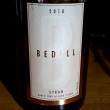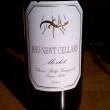
Winemaker Johannes Reinhardt at the Tierce blending session
By Evan Dawson, Finger Lakes Correspondent
All photos by Morgan Dawson
"These are the most precocious aromatics I've ever seen at this point in a wine's development," Peter Bell said, surveying more than 40 glasses containing Riesling blends from the 2008 vintage. "I mean, it's December. This is remarkable. Wine does what it wants to do, and the aromatics could drop a cliff. But I doubt it. This is just remarkable."
This is not propaganda. Some winemakers play up the virtues of each vintage. They have to answer to accountants, after all. But
Fox Run Vineyards winemaker Peter Bell's assessment came in the privacy of the 2008 Tierce riesling blending session. He made these comments to fellow winemakers Dave
Whiting of
Red Newt Cellars and Johannes Reinhardt of
Anthony Road Wine Company, not to the press or potential customers.
Tierce is entering its fifth vintage in the Finger Lakes. Conceived by Reinhardt, Tierce combines the winemaking talents and best riesling lots from three Seneca Lake wineries. The only exception came in 2007 when the winemakers agreed that the hot, draught-stressed vintage offered a rare opportunity to create a red wine together. Tierce Red, or Tierce 2007, is still in barrel and won't see the public until at least next summer.
Last week they were joined by their assistant winemakers: Tricia Renshaw (Fox Run), Brandon Seager (Red Newt) and Peter Becraft (Anthony Road). The six of them spent hours blending and tasting and re-blending and tasting, searching for the right balance for Tierce 2008 Riesling.

And what were they searching for? "A wine that is linear, intense, and looooong," Bell explained.
In other words, they were searching for the kind of dry riesling that has come to define the very best that Finger Lakes winemakers can offer. It is not meant to mimic the great Rieslings of Mosel or Alsace; it is meant to be ripping and crisp, electric but balanced, with less of the lush edges found in Europe's best of the aromatic whites. Each winemaking team brought four lots of riesling with which to start, and after a day spent tasting and debating they pared the blending components down to six.
Reconvening a week later with fresh energy and focus, each winemaker created a new blend, privately choosing different percentages from the various remaining lots. Some of the lots provided mouth-filling fruit; others offered the crackling acidity that evolves in the best cool-climate regions. Each new blend was scored and discussed, with some scrapped instantly and others highlighted as base components for yet new trials.
 When Whiting wanted to convince his colleagues to keep one lot in play, he urged them, "Think of this one as our child. It's time to find out how our child plays with others." As the hours passed the winemakers spit out metaphors like jacks from a destemmer; they were looking for creative ways to sway the room.
When Whiting wanted to convince his colleagues to keep one lot in play, he urged them, "Think of this one as our child. It's time to find out how our child plays with others." As the hours passed the winemakers spit out metaphors like jacks from a destemmer; they were looking for creative ways to sway the room.
Finally, with five new blends on the table, an eruption rocked the lab and sent tremors through the massive steel tanks standing only a few feet outside. Five of the six winemakers awarded the top score possible to one of the blends — it was nearly unanimous and instantly clear that Tierce 2008 had been born.
Through the din of the cheers and clapping, Reinhardt pounded a celebratory fist on the lab table. The sound of exploding wine glasses immediately silenced the room, but only for a moment before laughter covered Reinhardt's embarrassed grin.
"We've got a new baby," he said proudly. "You just saw the birth of the new Tierce."
Reinhardt, Bell and Whiting expect that they'll keep the same price — $30, one of the most expensive in the appellation. They'll deliver their baby to the public in mid-2009 and wine drinkers will have a chance to determine if the many hours and painstaking blending trials produced a wine worthy of the effort.

 When Whiting wanted to convince his colleagues to keep one lot in play, he urged them, "Think of this one as our child. It's time to find out how our child plays with others." As the hours passed the winemakers spit out metaphors like jacks from a destemmer; they were looking for creative ways to sway the room.
When Whiting wanted to convince his colleagues to keep one lot in play, he urged them, "Think of this one as our child. It's time to find out how our child plays with others." As the hours passed the winemakers spit out metaphors like jacks from a destemmer; they were looking for creative ways to sway the room.



















Interesting post, makes me excited to try it.
Was $30 the price of the Riesling though?
I thought only L.I. could charge that much for whites? lol
Bryan,
They’ve been selling previous vintages of Tierce for $30 and the winemakers find the price more than appropriate given the work hours and, more importantly, the quality.
You’re going to see some new, higher prices from other places as well. Some of the TBA from this vintage will fetch upwards of $100 or more, and Dave Whiting at Red Newt is putting a lot of focus on his Curry Creek Gewurz, which could see a new high for a FL gewurz.
One of the great things about riesling is how wonderfully it can refect the site that the grapes are grown upon. Now you are asking us to pay more to drink a blended version? FWIW, I’ve had tasted the Tierce that is currently on the market and don’t think it is worth $30. I’m really hoping the Finger Lakes doesn’t become the next CA/OR, with everyone trying to push overmanipulated single-vineyard wines with silly prices.
Cyclist,
My role is not to defend the winemakers or their vision for Tierce, but I wanted to comment on what you wrote. First, I can not agree more regarding Riesling’s wonderful ability to express its place. In my opinion, one of the reasons that FL Riesling is improving in quality and reputation is that producers are, by and large, not interested in attempting to emulate other styles or other places. They are finding that a distinctive, dry and crisp style is what this region offers.
With Tierce, I can only tell you that this discussion came up on numerous occasions during the blending sessions. I don’t have a perfect transcription of all dialogue in my notes, but on page of notes I wrote the following about a new round of blends:
“Blend 14 - Unique, very crisp… Bell says it’s ‘out of place’… they agree it doesn’t express FL well”
The process feels like science, but there is plenty of art in trying to acheive a beautiful Riesling from multiple lots that is still appropriately expressive of its place. That very issue is what hung up many of the blends.
In other words, they will have failed if they make a Riesling that is lovely and yet unexpressive of its place. They don’t believe it’s inherently impossible to create a blended wine that is expressive of its place; rather, they tell me that with effort and time they believe they can create a Riesling that unifies elements of different, emblematic FL sites (lime peel, lemon curd, wet stone, a touch of tropical fruit).
Now, having said all that, I don’t begrudge anyone the right to desire a single-vineyard or single-estate Riesling over any blended Riesling. There are large parts of me that feel the same way. I’m more of an old-world purist than a new-world radical, and I tend to prefer wines purely of one site. But I’m open to the result produced through this venture (and I’ve tasted the results before, which have been distinctive and impressive).
Evan - thanks for your thoughtful response. I’d be all for the concept of Tierce if I thought the blended wine was vastly superior other 2006 FL rieslings. But I can’t honestly say I was impressed.
Many of the old world vineyard designated wines come from sites where wine has been produced long enough so that the characteristics of that site are well known. But with a lot of new world wines I cynically see an attempt to produce a ‘premium’ product with a higher profit margin, simply by emulating the site specific labling of the old world wines. When I look at the proliferation of CA wines with ridiculous prices sporting vineyards with no known track record I simply walk away.
There are good reasons besides prestige that some of the great old-world sites fetch high prices: difficult terrain, old vines, low yields, tiny acerage (scarcity), cluster thinning/sorting…..
Nevertheless, one can still enjoy some great wines for less than the price of Tierce. Just last week I had a sub $20 Uerziger Wurtzgarten riesling kabinett from Christoffel which was absolutely delightful. It might be awhile before sites as great as Wurtzgarten are identified in the FL……
Cyclist,
You and I probably not that far apart on this issue. You’ve perfectly expressed the reasons why I hold so much disdain for west coast wines — and that’s before we even get to 30 brix, reverse osmosis, over extraction, etc.
Everyone has their own perception of value. When it comes to quality Riesling, there is plenty to be had for less than $30. The FL continues to struggle in terms of value across many varietals — largely because their production volume is so small compared to most regions.
I don’t blame anyone for being inherently cynical or skeptical about joint-release wines. When it comes to Tierce, there’s a much more pure and respectable story. Johannes Reinhardt left his family winery in Germany because he felt no room to try new things and even discuss his ideas with neighbors. When he got to the FL, he eagerly wanted to share his talents and thoughts with his neighbors, and he had finally found a place where that was accepetable. Through his gregarious approach to winemaking, Tierce was born — not through some marketing scheme designed to rake in cash.
There’s much more to Johannes’ story (as well as Dave and Peter’s) that I’ll share in my upcoming book on FL winemakers.
Thanks for your remarks here. They serve as an important reminder that a wine’s sense of place is valuable as anything else — more so, really.